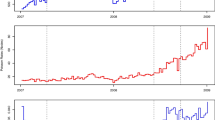Abstract
In this paper, a random graph process {G(t)} t≥1 is studied and its degree sequence is analyzed. Let {W t } t≥1 be an i.i.d. sequence. The graph process is defined so that, at each integer time t, a new vertex with W t edges attached to it, is added to the graph. The new edges added at time t are then preferentially connected to older vertices, i.e., conditionally on G(t-1), the probability that a given edge of vertex t is connected to vertex i is proportional to d i (t-1)+δ, where d i (t-1) is the degree of vertex i at time t-1, independently of the other edges. The main result is that the asymptotical degree sequence for this process is a power law with exponent τ=min{τW,τP}, where τW is the power-law exponent of the initial degrees {W t } t≥1 and τP the exponent predicted by pure preferential attachment. This result extends previous work by Cooper and Frieze.
Similar content being viewed by others
References
Aiello, W., Chung, F. and Lu, L., Random evolution in massive graphs, in Handbook of Massive Data Sets, Massive Comput. 4, pp. 97–122, Kluwer, Dordrecht, 2002.
Barabási, A. L. and Albert, R., Emergence of scaling in random networks, Science 286 (1999), 509–512.
Berestycki, N. and Durrett, R., A phase transition in the random transposition random walk, Probab. Theory Related Fields 136 (2006), 203–233.
Bianconi, G. and Barabási, A.-L., Bose–Einstein condensation in complex networks, Phys. Rev. Lett. 86:24 (2001), 5632–5635.
Bianconi, G. and Barabási, A.-L., Competition and multiscaling in evolving networks, Europhys. Lett. 54:4 (2001), 436–442.
Bollobás, B., Borgs, C., Chayes, J. and Riordan, O., Directed scale-free graphs, in Proceedings of the Fourteenth Annual ACM-SIAM Symposium on Discrete Algorithms (Baltimore, MD, 2003), pp. 132–139, ACM, New York, 2003.
Bollobás, B., Janson, S. and Riordan, O., The phase transition in inhomogeneous random graphs, Random Structures Algorithms 31 (2007), 3–122.
Bollobás, B. and Riordan, O., Mathematical results on scale-free random graphs, in Handbook of Graphs and Networks, pp. 1–34, Wiley, Weinheim, 2003.
Bollobás, B., Riordan, O., Spencer, J. and Tusnády, G., The degree sequence of a scale-free random graph process, Random Structures Algorithms 18 (2001), 279–290.
Borgs, C., Chayes, J., Daskalakis, D. and Roch, C., First to market is not everything: an analysis of preferential attachment with fitness, in Proceedings of the 39th annual ACM symposium on the theory of computation, pp. 135–144, 2007.
Britton, T., Deijfen, M. and Martin-Löf, A., Generating simple random graphs with prescribed degree distribution, J. Stat. Phys. 124 (2006), 1377–1397.
Chung, F. and Lu, L., The average distances in random graphs with given expected degrees, Proc. Natl. Acad. Sci. USA 99:25 (2002), 15879–15882.
Chung, F. and Lu, L., Connected components in random graphs with given expected degree sequences, Ann. Comb. 6 (2002), 125–145.
Cooper, C. and Frieze, A., A general model of web graphs, Random Structures Algorithms 22 (2003), 311–335.
Ergün, G. and Rodgers, G. J., Growing random networks with fitness, Phys. A 303 (2002), 261–272.
Faloutsos, C., Faloutsos, P. and Faloutsos, M., On power-law relationships of the internet topology, Computer Communications Reviews 29 (1999), 251–262.
Feller, W., An Introduction to Probability Theory and its Applications. Vol. II, Wiley, New York, 1971.
Grimmett, G. R. and Stirzaker, D. R., Probability and Random Processes, Oxford University Press, New York, 2001.
Gut, A., Probability: A Graduate Course, Springer Texts in Statistics, Springer, New York, 2005.
Hagberg, O. and Wiuf, C., Convergence properties of the degree distribution of some growing network models, Bull. Math. Biol. 68:6 (2006), 1275–1291.
Hall, P., Order of magnitude of moments of sums of random variables, J. London Math. Soc. 24 (1981), 562–568.
van der Hofstad, R. and Hooghiemstra, G., Diameters in preferential attachment models, Preprint, 2007.
Jordan, J., The degree sequences and spectra of scale-free random graphs, Random Structures Algorithms 29 (2006), 226–242.
Katona, Z. and Móri, T. F., A new class of scale free random graphs, Statist. Probab. Lett. 76:15 (2006), 1587–1593.
Kumar, R., Raghavan, P., Rajagopalan, S., Sivakumar, D., Tomkins, A. and Upfal, E., Stochastic models for the web graph, in 41st Annual Symposium on Foundations of Computer Science (Redondo Beach, CA, 2000), pp. 57–65, IEEE Comput. Soc. Press, Los Alamitos, CA, 2000.
Kumar, R., Raghavan, P., Rajagopalan, S. and Tomkins, A., Trawling the web for emerging cyber communities, Computer Networks 31 (1999), 1481–1493.
Newman, M. E. J., The structure and function of complex networks, SIAM Rev. 45 (2003), 167–256.
Pickands, III, J., Moment convergence of sample extremes, Ann. Math. Statist. 39 (1968), 881–889.
Söderberg, B., General formalism for inhomogeneous random graphs, Phys. Rev. E 66:6 (2002), 6 pp.
Szymański, J., Concentration of vertex degrees in a scale-free random graph process, Random Structures Algorithms 26 (2005), 224–236.
Author information
Authors and Affiliations
Corresponding author
Rights and permissions
About this article
Cite this article
Deijfen, M., van den Esker, H., van der Hofstad, R. et al. A preferential attachment model with random initial degrees. Ark Mat 47, 41–72 (2009). https://doi.org/10.1007/s11512-007-0067-4
Received:
Published:
Issue Date:
DOI: https://doi.org/10.1007/s11512-007-0067-4




